

Zitierweise / cite as:
Payer, Alois <1944 - >: Chronik Thailands = กาลานุกรมสยามประเทศไทย. -- Chronik 1987 / B. E. 2530. -- 2. datiert. -- Fassung vom 2017-03-19. -- URL: http://www.payer.de/thailandchronik/chronik1987b.htm
Erstmals publiziert: 2012-10-09
Überarbeitungen: 2017-03-19 [Ergänzungen] ; 2017-01-12 [Ergänzungen] ; 2016-08-29 [Ergänzungen] ; 2016-05-13 [Ergänzungen] ; 2016-04-25 [Ergänzungen] ; 2016-03-23 [Ergänzungen] ; 2015-12-29 [Ergänzungen] ; 2015-06-02 [Ergänzungen] ; 2015-04-26 [Ergänzungen] ; 2014-11-02 [Ergänzungen] ; 2014-09-24 [Ergänzungen] ; 2014-04-10 [Ergänzungen] ; 2014-02-19 [Ergänzungen] ; 2013-10-12 [Ergänzungen] ; 2013-05-22 [Ergänzungen] ; 2013-04-29 [Ergänzungen] ; 2013-04-27 [Teilung des Jahrgangs] ; 2013-04-21 [Ergänzungen] ; 2013-04-06 [Ergänzungen] ; 2013-03-30 [Ergänzungen] ; 2013-02-13 [Ergänzungen] ; 2013-01-25 [Ergänzungen] ; 2013-01-13 [Ergänzungen]
©opyright: Dieser Text steht der Allgemeinheit zur Verfügung. Eine Verwertung in Publikationen, die über übliche Zitate hinausgeht, bedarf der ausdrücklichen Genehmigung des Herausgebers.
Dieser Text ist Teil der Abteilung
Thailand von
Tüpfli's Global Village Library
ช้างตายทั้งตัวเอาใบบัวปิดไม่มิด
|
Gewidmet meiner lieben Frau Margarete Payer die seit unserem ersten Besuch in Thailand 1974 mit mir die Liebe zu den und die Sorge um die Bewohner Thailands teilt. |
|
Bei thailändischen Statistiken muss man mit allen Fehlerquellen rechnen, die in folgendem Werk beschrieben sind:
Die Statistikdiagramme geben also meistens eher qualitative als korrekte quantitative Beziehungen wieder.
|
1987-01
Phra Kru Kantayaphiwat von Wat Sra Kaew (วัดสระแก้ว), Amphoe Pa Mok (ป่าโมก), Provinz Ang Thong (อ่างทอง), erhält den Norwegian Children's Peace Prize dafür, dass er in den letzten vierzig Jahren über 2000 Waisenkinder aufgenommen hat.
Abb.: Lage von Amphoe Pa Mok (ป่าโมก)
[Bildquelle: OpenStreetMap. -- Creative Commons Lizenz (Namensnennung, share alike)]
1987-01-01
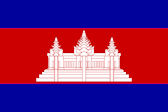
Das Flüchtlingslager Khao-I-Dang (ខៅ អ៊ី ដាង) darf auf Anweisung der Regierung keine kambodschanischen Flüchtlinge mehr aufnehmen. Viele Flüchtlinge drängen an den Zaun, werden aber nicht eingelassen.
Abb.: Lage von Khao-I-Dang (ខៅ អ៊ី ដាង)
[Bildquelle: OpenStreetMap. -- Creative Commons Lizenz (Namensnennung, share alike)]
Abb.: Spital im Flüchtlingslager Khao-I-Dang (ខៅ អ៊ី ដាង)
[Bildquelle: Chhan Touch / Wikipedia. -- GNU FDLicense]
"Khao-I-Dang Holding Center was a Cambodian refugee camp located 20 km north of Aranyaprathet (อรัญประเทศ) in Prachinburi (ปราจีนบุรี, now Sa Kaeo - สระแก้ว) Province of Thailand. The most enduring refugee camp on the Thai-Cambodian border, it was established in late 1979 and administered by the Thai Ministry of the Interior and UNHCR--unlike other camps on the border, which were administered by a coalition made up of UNICEF, the World Food Program, ICRC (briefly) and, after 1982, the United Nations Border Relief Operation (UNBRO). [...]
Camp PopulationOn October 19, 1979 Thai Prime Minister Kriangsak Chomanan (พลเอกเกรียงศักดิ์ ชมะนันทน์) enacted an "open door" policy which permitted Cambodian refugees to cross the border safely and to reside in specific locations. Khao-I-Dang (known to aid agencies as KID) was intended to serve as a temporary holding center for refugees who would either be repatriated to Cambodia or expatriated to third countries. On the first day 4,800 people arrived and by December 31 there were 84,800. Between November 1979 and the end of January 1980 an average of 1,600 refugees arrived in the camp each day. Thailand's open door policy was abruptly ended on January 24, 1980 and KID was "closed" to new arrivals.
Originally planned to hold 300,000 refugees, the population eventually reached 160,000 in March 1980. Later, as KID became the main holding center for refugees awaiting third country visas, illegal entry to the camp became highly sought after by refugees desperate to escape from Cambodia, and smuggling, theft and violence spiraled out of control. In July and August 1980 UNHCR began transferring large numbers of refugees out of KID to Phanat Nikhom (พนัสนิคม), Sa Kaeo II (สระแก้ว II), Mai Rut (ไม้รูด), and Kap Choeng (กาบเชิง). By December 1982 the population had dropped to 40,134 as refugees were forcibly repatriated, sent to third countries, or sent back to the border camps.
[...]
Camp ClosureKhao-I-Dang's size steadily declined as its population was resettled in other countries. It eventually became a camp made up of persons who had been rejected for resettlement; many had been rejected by more than one country. With the prospects of further resettlement diminishing, Thailand declared the camp closed at the end of December 1986. Relocations to border camps of the illegal camp residents began in March 1987. In response to international pressure, selection for resettlement of the residual population was extended again in 1988, after which Thai authorities officially decreed that all remaining refugees would be transferred to the border for repatriation to Cambodia. The residents of KID were vocal in opposition to what they felt was a forced repatriation and held numerous demonstrations. By December 1989 camp population was 11,600.
The camp finally closed on 3 March 1993 during the UNTAC operation when all remaining residents were moved to Site Two Refugee Camp to await repatriation to Cambodia. At the closing ceremony, then UNHCR Special Envoy Sérgio Vieira de Mello called KID a "powerful and tragic symbol" of the Cambodian exodus and the international humanitarian response."
[Quelle: http://en.wikipedia.org/wiki/Khao-I-Dang. -- Zugriff am 2011-12-10]
1987-01-04
Offizielle Eröffnung des "Visit Thailand Year". Der Gouverneur von Bangkok, Chamlong Srimuang (จำลอง ศรีเมือง), verbietet allen Straßenverkauf. Um das Verbot durchzusetzen, darf die Polizei alle Straßenverkäufer verhaften, die den Fußgängerverkehr behindern. Deswegen kommt es zu Demonstrationen vieler Straßenverkäufer.
1987-01-04
Bangkok Post:
"Reopen Hooppha Sawan for tourists": Suchart Kosolkittiwong [สุชาติ โกศลกิติวงศ์ aka. Ariyavamso Bhikkhu - อริยวังโสภิกขุ, 1943 - 2005], former leader of the Hoopha Sawan Religious Centre, has urged the Government to reopen the controversial site as a tourist attraction. It is located in Pak Tho District [ปากท่อ] of Ratchaburi Province [ราชบุรี].
Abb.: Lage von Amphoe Pak Tho (ปากท่อ)
[Bildquelle: OpenStreetMap. -- Creative Commons Lizenz (Namensnennung, share alike)]Mr. Suchart was charged with illegal renovation of the ruins at the site and illegal encroachment on public property. His cases are being forwarded to the court.
He said that since the Government had proclaimed 1987 as "Visit Thailand Year," it should take the advantage of a large investment in the religious centre and reopen it for foreign tourists and the public.
Mr. Suchart once spoke of his aim to establish a world government based at Hooppha Sawan and was called "world peace envoy" by his followers.
He said that more than 30 million baht collected from his followers had been spent to construct statues of various religious figures. He said other tourist attractions there include the Salika Cave, the holy image of "Luang Poo Thuad," [หลวงปู่ทวด, 1582 - 1682] the 559 man-made concrete steps to the Peace Pagoda on a mountain peak, a nine-meter Statue of the Buddha and another of Jesus Christ.
Hooppha Sawan was ordered closed in 1982 by Ratchaburi authorities after an arms cache was uncovered in front of its entrance. Six charges were filed against Mr. Suchart who surrendered to police last year after five years in hiding.
He said that before the centre was closed, he had intended to turn it over to the Government for public visits and study.
Ratchaburi MP Pol Lt Chaovarin Latthasaksiri once proposed that the Education Ministry turn the site into a provincial college, but no action was taken by the Government."
[Zitiert in: Heinze, Ruth-Inge <1919 - 2007>: Trance and healing in Southeast Asia today. -- Bangkok, Thailand : White Lotus, 1988. -- 406 S. : Ill. ; 22 cm. -- ISBN 974-8495-18-3. -- S. 277f.]
1987-01-08

Mrs. Sujarinee Vivacharawongse (née Yuvadhida Polpraserth, 1962 - ) (พระองค์ที่ประสูติแต่ สุจาริณี วิวัชรวงศ์) gebiert dem Kronprinzen Vajiralongkorn eine Tochter: Prinzessin Busya Nambejra Mahidol (หม่อมเจ้าหญิงบุษย์น้ำเพชร มหิดล,), 2005-06-15 durch königliches Dekret ernannt zu Phra Chao Lan Thoe Phra Ong Chao Sirivannavari Nariratana (พระเจ้าหลานเธอ พระองค์เจ้าสิริวัณณวรีนารีรัตน์)
Abb.: Phra Chao Lan Thoe Phra Ong Chao Sirivannavari Nariratana (พระเจ้าหลานเธอ พระองค์เจ้าสิริวัณณวรีนารีรัตน์), 2011-08-08
[Bildquelle: U.S. Navy photo by Seaman Tatiana Avery / Wikipedia. -- Public domain]
"Phra Chao Lan Thoe Phra Ong Chao Sirivannavari Nariratana (Thai: พระเจ้าหลานเธอ พระองค์เจ้าสิริวัณณวรีนารีรัตน์; * 8. Januar 1987 in Bangkok, geboren als Mom Chao Busyanambejra Mahidol) ist eine thailändische Prinzessin, Modedesignerin und Badmintonspielerin. Leben
Sirivannavari Nariratana wurde 1987 als Tochter von Kronprinz Maha Vajiralongkorn und Mom Sujarinee Mahidol (สุจาริณี วิวัชรวงศ์ หรือชื่อเดิมคือ ยุวธิดา สุรัสวดี), bekannt als Yuvadhida Polpraserth (ยุวธิดา ผลประเสริฐ, 1962 - ), unter dem Namen Mom Chao Busyanambejra Mahidol geboren. Sie ist die Jüngste von fünf Geschwistern. Nach der Scheidung ihrer Eltern ging sie nach England, kehrte aber später wieder nach Thailand zurück und studierte dort Mode und Textil an der Chulalongkorn-Universität (จุฬาลงกรณ์มหาวิทยาลัย). 2007 wählte sie das Forbes Magazin in die Top 20 der "Hottest Young Royals".
Sportliche KarriereSirivannavari Nariratana widmet sich auf sportlichem Gebiet dem Badminton. Als größten Erfolg konnte sie 2007 den Gewinn der Bronzemedaille mit dem thailändischen Team bei den Südostasienspielen verzeichnen. Im Mixed schied sie dagegen bei der gleichen Veranstaltung in der ersten Runde aus. Auch bei den Thailand Open 2006 war in Runde eins Endstation."
[Quelle: http://de.wikipedia.org/wiki/Sirivannavari_Nariratana. -- Zugriff am 2012-04-02]
1987-01-09

Unterzeichnung des Agreement relating a war reserve stockpile program mit den USA. Das Abkommen sieht vor, dass die USA in Thailand ein Arsenal von Waffen, Munition und anderen Kampfmitteln lagern dürfen.
1987-01-15

Wegen seiner "weichen" Haltung gegenüber den protestierenden Studenten 1986 muss der Generalsekretär der Kommunistischen Partei Chinas (中国共产党中央委员会总书记), Hu Yaobang (胡耀邦, 1915 - 1989), zurücktreten.
Abb.: Hu Yaobang (胡耀邦), 1989
[Bildquelle: Wikipedia. -- Fair use]
1986-01-16 - 1989-06-23

Zhào Zǐyáng (赵紫阳, 1919 - 2005) ist Generalsekretär der Kommunistischen Partei Chinas (中国共产党中央委员会总书记).
Abb.: Zhào Zǐyáng (赵紫阳), 1984
[Bildquelle: TSGT Bert Mau / Wikimedia. -- Public domain]
1987-01-16
Abb.: Sanitsuda Ekachai (สนิทสุดา เอกชัย)
[Bildquelle: FAO]Bangkok Post: Sanitsuda Ekachai (สนิทสุดา เอกชัย, 1955 - ): "Small efforts - big results"
Foundation of Education for Life and Society (มูลนิธิการศึกษาเพื่อชีวิตและสังคม) unterstützt 200 Lehrer, die in ihrer Freizeit Graswurzel-Unternehmungen in Dörfern anstoßen. Beispiele:
Grundschullehrerin Montien Klakarnkai in Ban Nong Pang Kha (หนองพังค่า), Provinz Uthai Thani (อุทัยธานี ), erkannte, dass sie zuerst die hungrigen Mägen ihrer Schüler füllen muss. Deshalb gründete sie einen Dorf-Enten-Hof, damit jedes Kind täglich ein Ei bekommt.
Abb.: Lage von Ban Nong Pang Kha (หนองพังค่า)
[Bildquelle: OpenStreetMap. -- Creative Commons Lizenz (Namensnennung, share alike)]
Abb.: Enteneier, Thailand, 2009
[Bildquelle: kinumi Yoshida. -- http://www.flickr.com/photos/kohsamui/3603081774/. -- Zugriff am 2012-05-10. -- Creative Commons Lizenz (Namensnennung, keine kommerzielle Nutzung)]Grundschullehrer Kittichot Hoyiipuu in Mae Chan (แม่จัน), Provinz Chiang Rai (เชียงราย), richtete einen Schul-Gemüsegarten ein, um traditionelle Gemüse und Pflanzen anzubauen, die keine teuren Düngemittel und Pestizide brauchen.
Abb.: Lage von Mae Chan (แม่จัน)
[Bildquelle: OpenStreetMap. -- Creative Commons Lizenz (Namensnennung, share alike)]Grundschullehrer Samrit Saotong in Amphoe Tha Tum (ท่าตูม), Provinz Surin (สุรินทร์) baute einfache Hütten für Kinder, die einen weiten Schulweg haben, dass sie bei der Schule übernachten können. Inzwischen ist es ein kleines Kinderdorf, in dem die Kinder auch Gemüse anbauen.
Abb.: Lage von Amphoe Tha Tum (ท่าตูม)
[Bildquelle: OpenStreetMap. -- Creative Commons Lizenz (Namensnennung, share alike)]Grundschullehrerin Siripan Saisangjand in Ban Prasat (บ้านปราสาท), Provinz Surin (สุรินทร์), führte Puppenspiele als Lehrmittel ein. Die Puppen werden aus den verschiedensten Materialien hergestellt. Die Eltern sind stolz auf die Kreativität ihrer Kinder.
Abb.: Lage von Ban Prasat (บ้านปราสาท)
[Bildquelle: OpenStreetMap. -- Creative Commons Lizenz (Namensnennung, share alike)]"What they are doing is not dramatic. Nor is it revolutionary. But with each small step forward, these small people are effecting real change at the grassroot level."
1987-01-17


Eine halbe Million Menschen aus ganz Thailand wohnen der Kremation von Luang Pu Waen Sujinno (หลวงปู่แหวน สุจิณโณ, 1887 - 1985) im Wat Doi Mae Pang (วัดดอยแม่ปั๋ง), Amphoe Phrao (พร้าว), Provinz Chiang Mai (เชียงใหม่), bei. Luang Pu Waen war einer der angesehendsten Mönche Thailands. Er war am 2. Juli 1985 gestorben. Vorsitz über die Kremation hat das Königspaar.
Abb.: Luang Pu Waen Sujinno (หลวงปู่แหวน สุจิณโณ)
[Bildquelle: th.Wikipedia. -- Fair use]
Abb.: Lage der Amphoe Phrao (พร้าว)
[Bildquelle: OpenStreetMap. -- Creative Commons Lizenz (Namensnennung, share alike)]
"Luang Pho Waen Sujinno (Thai: หลวงปู่แหวน สุจิณโณ, RTGS: Luang Pu Waen Su-Chin-No, also Phra Ajahn Waen Sujinno, popularly known as Luang Pho Waen meaning Venerable Grandfather; 16 February 1888 – 2 July 1985) is one of the longest living students of Phra Ajahn Mun Bhuridatta (มั่น ภูริทตฺโต / ຫຼວງປູ່ ມັ່ນ ພູຣິທັຕໂຕ) and was a very popular monk in Thailand. Luang Pho Waen Sujinno was also featured in the Asia Magazine. Another true ascetic at heart, he led the thudong (ธุดงค์) life until the point where he could not physically travel any more and had to settle in a forest monastery in the Chiang Mai (เชียงใหม่) region.
Luang Pho Waen Sujinno was a revered monk, highly skilled in Samadhi and Dhamma. The most remarkable characteristic of Luang Pho Waen was his dislike of crowded places. He loved to live alone in the forests away from people and urbanized areas just like his teacher, Ajahn Mun Bhuridatta. Some people said that Luang Pho Waen had achieved Arahant level. Tahn Joo Koon Noh had in fact mentioned that "There is a Phra Arahant, but he lives far away, in the forest".
BiographyLuang Pho Waen was born on 16 February 1883 (BE 2431) in Tambon Na Pong (นาโป่ง), Mueang District of Loei (เลย), Northeast (Isan - อีสาน) of Thailand to a blacksmith's family. He was named Yarn and had one elder sister. He ordained as a novice in 1892 at Wat Bodhi Chai (วัดโพธิ์ชัยมงคล) in Na Pong at the age of nine to fulfill the wish of his mother when she died while he was five years old. At the age of 13, he became a Naen (novice monk) at Wat Poh Chai, Loei province. He studied with a number of teachers and later ordained as a monk at a temple in Hua Taparn District of Ubon Ratchathani (อุบลราชธานี) at the age of 21.
As a novice monk, he studied the Dharma and Pali, even at that young age he showed exceptional ability. He eventually went Thudong (forest monk) with his teacher, Ajahn Wuhan, travelling from Loei to Ubon Ratchathani, where he remained to learn Dhamma from another teacher, Ajahn Sing.
During his Thudong, he met many disciples of Ajahn Mun whom he had wanted to further his studies under. Luang Pho Waen met Ajahn Mun in BE 2462 (at the age of 31) at Bahn Kor forest, Udon Thani province. Luang Por Mun Bhuridatta in Udon Thani who taught him the pursuance of a secluded life and the practice of meditation and Dhamma in the jungles. Subsequently Luang Pho Waen travelled very widely in the Northeast of Thailand in search of isolated places where he could meditate. His travelling also took him to Bangkok where he met Chao Khun Phra Upali Gunupamacariya of Wat Bowonniwet (วัดบวรนิเวศวิหารราชวรวิหาร) in 1921 with whom Luang Pho Waen spent several years studying and practising the Dhamma. Later Chao Khun Phra Upali took him to Wat Chedi Luang (วัดเจดีย์หลวง) in Chiang Mai where Luang Pho Waen decided to change from the Maha-Nikaya sect of Buddhism to the stricter Dhammayut sect (ธรรมยุติกนิกาย).
Later he went Thudong again with Ajahn Dteu. Luang Pho Waen, endured many difficulties during his Thudong, he encountered ghosts, wild animals and other dangers but was never afraid despite warnings from local villagers. It was his wish to experience and learn from everything.
Luang Pho Waen spent most of his monkhood as a forest monk, travelling from one province to another on foot, climbing hills, crossing rivers and deep forests. He had also went as far as Laos, Cambodia, Burma and even Vietnam on Thudong. At BE 2470, age 39, Luang Pho Waen arrived in Lampang (ลำปาง).
He met another disciple of Ajahn Mun called Ajahn Keow. He was told that Ajahn Mun was in Chiang Mai. Luang Pho Waen quickly Thudong to Chiang Mai to look for Ajahn Mun. Finally he met Ajahn Mun and Ajahn Dteu at Wat Chedi Luang. Ajahn Mun officially accepted Luang Pho Waen as his disciple. He studied Dhamma at Wat Chedi Luang.
After Ajahn Mun left Wat Chedi Luang for Thudong, Luang Pho Waen also went Thudong in Chiang Mai. He stayed at Wat Huainumrin in Chiang Mai Province for 10 years. During his long stay in Wat Huainumrin, he stayed most of his time in forests and only returning to the temple during the rainy seasons (Khao Phansa).
Luang Pho Waen travelled extensively by foot through jungles and across mountains and even ventured to Burma and India where he paid homage to several historic Buddhist sites. However, in 1955 news of a foot injury sustained during his stay in seclusion of Wat Paa Ban Pong in Mae Tang District, Chiang Mai, reached Phra Ajahn Noo Suchitto of Wat Doi Mae Pang who later arranged for Luang Pho Waen to stay in Wat Doi Mae Pang permanently. He resided in Wat Doi Mae Pang (วัดดอยแม่ปั๋ง)) until his passing away.
Luang Pho Waen entered Maharaj Hospital (โรงพยาบาลมหาราช) on 15 April 1985 when he was found unable to eat or move and was operated on 4 June 1985 in order to feed him through a tube which was inserted into his stomach. However, complications developed and Phra Ajahn Noo, the abbot of Wat Doi Mae Pang, requested doctors not to perform any more operations as he wanted Luang Pho Waen to rest peacefully. His request was accepted by doctors and the Chiang Mai Governor, Mr. Chaiya Punsiriwong.
On 2 July 1985 at 9:54 pm, Luang Pho Waen finally died at the age of 102 years and 5 months [sic!] after having been in the monkhood for almost 90 years. He was given a royal-sponsored bathing ceremony at Sala Ang Klaew in Chiang Mai University (มหาวิทยาลัยเชียงใหม่)) which was attended by the King and Queen of Thailand as well as the general public. His remains were cremated at a Royal Funeral on 16 January 1986.
"Sujinno Building", a 15-level building of Maharat Nakhon Chiang Mai Hospital, was named in his honor.
Quotes“What is sacred? Everyone has something sacred within themselves. To have been born as a complete human being is already sacred. One can be sacred only from within oneself, and not by any amulet or other so-called sacred objects. Dhamma is sacred, and to have this sacredness, one must have Dhamma within oneself.”
(As a very popular monk, Luang Pho Waen is often rumoured to have “sacred amulets” - something which Thai people from all walks of life like to receive from revered monks - for their protective value. People from all over Thailand would often travel to Wat Doi Mae Pang to seek these amulets or other sacred objects from him. He would always give the same answer as the one quoted above.)
Further reading
- Acariya Maha Boowa: Venerable Acariya Mun Bhuridatta Thera, a Spiritual Biography. Wat Pa Baan Taad 2003, Baan Taad, Amphoe Muang, Udon Thani, 41000 Thailand (no ISBN, available at this address, or 4MB pdf-download here)"
[Quelle: http://en.wikipedia.org/wiki/Luang_Por_Waen_Sujinno. -- Zugriff am 2011-12-10]
1987-02/03

Kämpfe zwischen Thahan Phran (ทหารพราน, Rangers) und vietnamesischen und kambodschanischen Truppen an der Grenze zu Nordwestkambodscha.
Abb.: Lage von Nordwestkambodscha
[Bildquelle: OpenStreetMap. -- Creative Commons Lizenz (Namensnennung, share alike)]
1987-02-06
In einer illegal errichteten Lederwarenfabrik in Samut Prakan (สมุทรปราการ) kommen bei einem Brand 19 Personen ums Leben und 5 werden schwer verletzt. Die Personen konnten nicht fliehen, da die Fenster zum Schlafraum der Arbeiterinnen und ihrer Kinder mit Eisengittern verschlossen waren.
Abb.: Lage von Samut Prakan (สมุทรปราการ)
[Bildquelle: OpenStreetMap. -- Creative Commons Lizenz (Namensnennung, share alike)]
1987-02-07

Tod von Ursulinenschwester Marie Xavier (aka. Xaveria, geborene Ana Pirc) (1894 - 1987) aus Laibach (Krain, Österreich-Ungarn, heute: Ljubljana, Slowenien), Lehrerin und später Direktorin der Mater Dei Schule (โรงเรียนมาแตร์เดอี) in Bangkok. König Bhumibol hatte seinen ersten Schul-Unterricht bei ihr.
Abb.: Sr. Xaveria
[Bildquelle: http://www.ursulinesth-ur.org/en/about-03.html. -- Zugriff am 2014-10-27]
1987-02-11
Der Gouverneur von Bangkok, Chamlong Srimuang (จำลอง ศรีเมือง), hat angeordnet, dass Geisterhäuschen (ศาลพระภูมิ) von Gehsteigen entfernt werden müssen, da sie ein Schandfleck seien und außerdem den Verkehr behinderten. Die städtischen Arbeiter weigern sich aber, in Phya Thai (พญาไท) Geisterhäuschen zu entfernen. Ein städtischer Beamter sollte daraufhin die vor einer Entfernung nötigen Riten vollziehen. Als er aber sah, wie viele Geisterhäuschen es sind, weigerte er sich.
Abb.: Lage von Phya Thai (พญาไท)
[Bildquelle: OpenStreetMap. -- Creative Commons Lizenz (Namensnennung, share alike)]
Abb.: Geisterhäuschen vor BMW-Autohaus, Bangkok, 2007
[Bildquelle: An-d / Wikimedia. -- GNU FDLicense]
1987-02-22
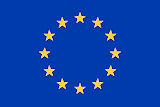
Erstflug des Mittelstrecken-Passagierflugzeugs Airbus A320.
Abb.: Thai AirAsia Airbus A300 in Mandalay, Myanmar, 2013
[Bildquelle: calflier001. -- http://www.flickr.com/photos/28984065@N04/8511604716. -- Zugriff am 2013-10-08. -- Creative Commons Lizenz (Namensnennung, share alike)]
1987-02-23

Tod von Edward Geary Lansdale (1908 – 1987)
Abb.: Edward Geary Lansdale, 1963
[Bildquelle: USAF/Wikimedia. -- Public domain]
"Edward Geary Lansdale (* 6. Februar 1908 in Detroit; † 23. Februar 1987 in McLean (Virginia)) war ein Offizier der United States Air Force, der unter anderem im Office of Strategic Services (OSS) und bei der Central Intelligence Agency (CIA) arbeitete. Er brachte es bis zum Dienstgrad eines Generalmajors und erhielt im Jahr 1963 die Air Force Distinguished Service Medal. Früh befürwortete er ein aggressiveres Vorgehen der USA im Kalten Krieg. Lansdale wurde auf dem Nationalfriedhof Arlington beerdigt. Er war zweimal verheiratet und hatte zwei Söhne aus seiner ersten Ehe. Kindheit und Jugend
Edward Geary Lansdale wurde im Jahr 1908 in Detroit, Michigan als zweiter von vier Söhnen von Sarah Frances Philips und Henry Lansdale geboren. Er besuchte Schulen in Michigan, New York und Kalifornien und studierte dann an der University of California, Los Angeles (UCLA), was er zunächst weitgehend durch das Schreiben von Artikeln für Zeitungen und Magazine, später durch besser bezahlte Jobs in der Werbung in Los Angeles und San Francisco finanzierte.
Zweiter WeltkriegIm Zweiten Weltkrieg diente Lansdale beim OSS. 1943 wurde er zum Leutnant in der United States Army ernannt, wobei er während des Krieges zahlreiche nachrichtendienstliche Aufgaben übernahm. Nach mehreren Beförderungen während des Krieges wurde er 1945 als Major ins Hauptquartier der US-Luftwaffe für den westlichen Pazifik versetzt, wo er die nachrichtendienstliche Abteilung leitete.
PhilippinenBis 1948 blieb er auf den Philippinen, wo er die philippinische Armee beim Wiederaufbau ihrer Nachrichtendienste unterstützte und für die Rückführung der zahlreichen philippinischen Kriegsgefangenen verantwortlich war. Im Jahr 1947 wurde er zum Hauptmann der US-Luftwaffe ernannt, mit dem vorläufigen Dienstgrad eines Majors. Nachdem er die Philippinen verlassen hatte, diente er als Dozent an der Strategic Intelligence School in der Lowry Air Force Base, Colorado, wo er 1949 eine zeitweilige Beförderung zum Oberstleutnant erhielt.
Im Jahr 1950 erbat der damalige philippinische Präsident Elpidio Quirino (1890 - 1956) persönlich seine Versetzung zur Joint United States Military Assistance Group auf den Philippinen, um die Nachrichtendienste der Streitkräfte beim Kampf gegen die kommunistischen Hukbalahap-Rebellen zu unterstützen. Der spätere philippinische Präsident Ramon Magsaysay (1907 - 1957) war kurz zuvor zum Verteidigungsminister ernannt worden und Lansdale wurde ihm als Verbindungsoffizier zur Seite gestellt. Die beiden Männer verband bald eine enge Freundschaft und sie besuchten häufig gemeinsam Kampfgebiete. Lansdale half den philippinischen Streitkräften bei der Entwicklung der psychologischen Kriegsführung und bei der Rehabilitation von Hukbalahap-Gefangenen.
VietnamLansdale gehörte im Jahr 1953 der US-Streitkräfte-Abordnung unter General John W. O’Daniel (1894 - 1975) in Indochina an und beriet dort die Französischen Streitkräfte bei Spezialoperationen („SpecOPs“) gegen die Việt Minh. Von 1954 bis 1957 war er als Leiter der Saigon Military Mission (SMM) im damaligen Saigon stationiert. In dieser Zeit betrieb er die Ausbildung der Vietnamese National Army (VNA), organisierte zu deren Unterstützung die Cao-Đài-Milizen unter Trình Minh Thế (1922 - 1955), startete eine Propagandakampagne als Teil der „Operation Passage to Freedom“, die die vietnamesischen Katholiken zum Umzug in den Süden des Landes ermutigen sollte, und ließ Behauptungen über Anschläge nordvietnamesischer Agenten in Südvietnam verbreiten. Vor dem weithin verurteilten Referendum im Jahre 1955, durch das Premierminister Ngô Đình Diệm (1901 - 1963) das Staatsoberhaupt Bảo Đại (1913 - 1997) des Amtes enthob und sich selbst als Präsident der neuen Republik Vietnam proklamierte, hatte Lansdale Diệm, mit dem ihn eine enge Freundschaft verband, geraten, die Abstimmung nicht zu manipulieren und mit einem realistischen Ergebnis von 60 bis 70 Prozent zufrieden zu sein, doch Diệm nahm diesen Rat nicht an. Er erhielt offiziell 98,2 % der Stimmen im ganzen Land und 133 % in Saigon.
Anti-Castro-KampagneVon 1957 bis 1963 arbeitete Lansdale im Verteidigungsministerium in Washington als „Deputy Assistant Secretary for Special Operations“, Mitglied des Stabes im „Committee on Military Assistance“ des US-Präsidenten und „Assistant Secretary“ für Spezialoperationen. Während der frühen 1960er Jahre war er hauptsächlich mit geheimen Umsturzplänen bezüglich Kuba – insbesondere im Zusammenhang mit der Operation Mongoose – befasst und schlug unter anderem ein Attentat auf Fidel Castro (1927 - ) vor. Laut dem Militärhistoriker Daniel Ellsberg (1931 - ), der zeitweise als Untergebener Lansdales arbeitete, behauptete Lansdale, seine Entlassung aus der Luftwaffe im Jahre 1963 sei von John F. Kennedys Verteidigungsminister Robert McNamara (1916 - 2009) veranlasst worden, nachdem er Kennedys Angebot abgelehnt habe, eine führende Rolle beim Sturz von Diệms Regime zu übernehmen.
Spätere KarriereVon 1965 bis 1968 kehrte Lansdale nach Vietnam zurück, um in der US-amerikanischen Botschaft als Berater des Botschafters, der südvietnamesischen Regierung und Direktor der verdeckten Operationen der CIA in Indochina zu arbeiten. Er vertrat die Vereinigten Staaten in einem Komitee der südvietnamesischen Regierung, welche die Landbevölkerung auf ihre Seite bringen wollte. Auf Lansdales Anraten propagierte der südvietnamesische Premierminister Nguyễn Cao Kỳ (1930 - 2011) zur Befriedung der ländlichen Regionen und Entfernung der Vietkong ein Wiederaufbauprogramm.
1972 wurden seine Memoiren „In the Midst of Wars“ veröffentlicht. Seine Biographie „The Unquiet American“, verfasst von Cecil Currey, erschien 1988. Ihr Titel bezieht sich auf die verbreitete, gleichwohl umstrittene Annahme, dass der Titelfigur von Graham Greenes (1904 - 1991) Roman „The Quiet American“ (dt.: „Der stille Amerikaner“) die reale Person Edward Lansdale zugrundeliege. Bei der Hollywood-Erstverfilmung von Greenes Romans 1958 durch Joseph L. Mankiewicz (1909 - 1993) nahm Lansdale Einfluss auf den Regisseur, damit der im Film dargestellte CIA-Agent – in kompletter Verdrehung der Darstellung im Roman – als Held und der britische Journalist als zwielichtiger Charakter dargestellt wurde. Greene war darüber empört und bezeichnete den Film als „Propagandafilm für Amerika“.[1]
Wahrscheinlich war Lansdale auch die Vorlage für die Figur Colonel Hillandale in dem 1958 veröffentlichten Roman „The Ugly American“ (dt.: „Der häßliche Amerikaner“) von Eugene Burdick (1918 - 1965) und William Lederer (1912 - 2009)."
[Quelle: https://de.wikipedia.org/wiki/Edward_Lansdale. -- Zugriff am 2016-08-29]
1987-02-24


Kronprinz Vajiralongkorn ist zwei Wochen lang auf Staatsbesuch in China. Er wird von Staatspräsident Li Xiannian (李先念) mit einem Staatsbankett geehrt. Er erhält 21 Salutschüsse wie ein Staatsoberhaupt.
1987-02-24
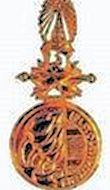
Zu National Artists (ศิลปินแห่งชาติ) werden ernannt:
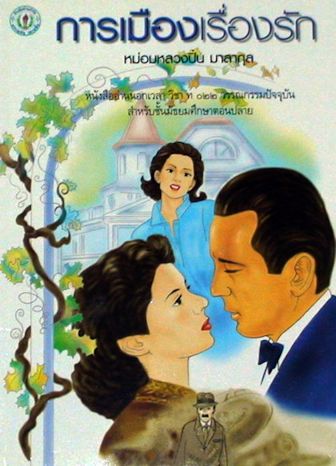
Abb.: Einbandtitel eines Buchs von Pin Malakul (หม่อมหลวงปิ่น
มาลากุล)
[Fair use]
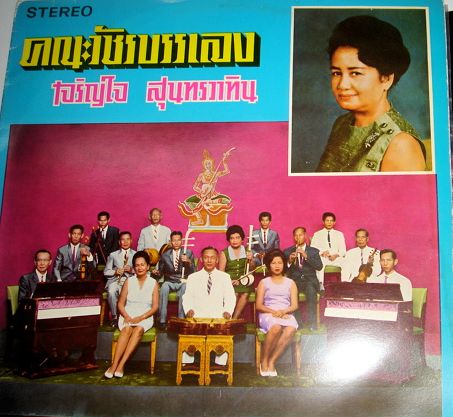
Abb.: Plattentitel von Jaroenjai Suntornwatin (นางเจริญใจ สุนทรวาทิน)
[Fair use]
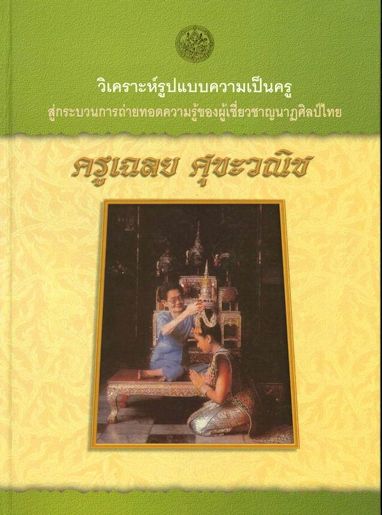
Abb.: Einbandtitel eines Buchs über Chaloey Sukavanis (นางเฉลย ศุขะวณิช)
[Fair use]
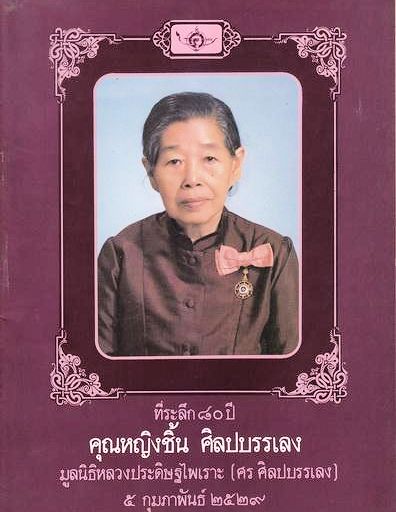
Abb.: Einbandtitel eines Buchs über Chin Silapabanleng (คุณหญิงชิ้น ศิลปบรรเลง)
[Fair use]
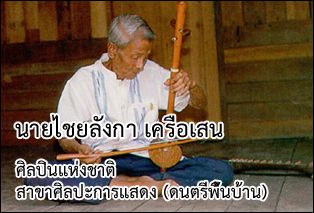
Abb.: Chailanka Kruasen (นายไชยลังกา เครือเสน)
[Bildquelle:
http://www.nan2day.com. -- Zugriff am 2013-04-15. -- Fair use]
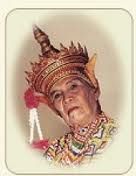
Abb.: Yok Choobua (ยก ชูบัว)
[Fair use]
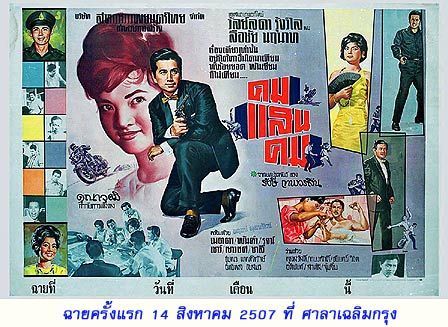
Abb.: Plakat des Films คมแสนคม von Vichit Kounavudhi
(วิจิตร คุณาวุฒิ), 1964
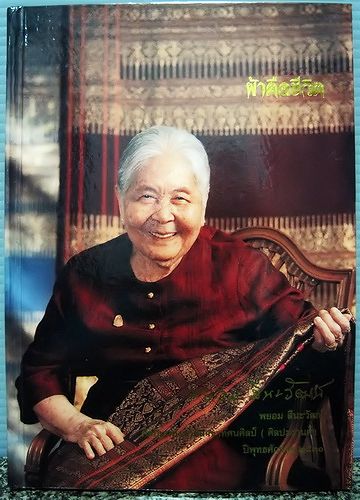
Abb.: Einbandtitel eines Buchs über Payom Sinawat
(นางพยอม สีนะวัฒน์)
[Fair use]
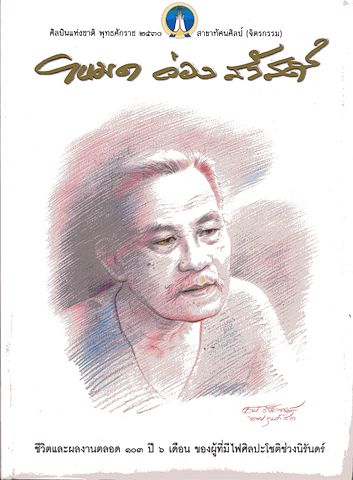
Abb.: Einbandtitel eines Buchs über Mod Wongsawad (นายโหมด ว่องสวัสดิ์)
[Fair use]
1987-03-03

""The Nation reported on 3 March 1987 that / 張奇夫 / จันทร์ จางตระกูล, 1934 - 2007] bases.""F-5E jets may be used in bombing Khun Sa's [ခွန်ဆာ
By mid-March, Thai army commander, Gen. Chavalit Yongchaiyut [ชวลิต ยงใจยุทธ, 1932 - ], touring the battlefront, declared that the campaign against Khun Sa had been "a success".12
But in April, only a few weeks later, the infamous US POW hunter James "Bo" Gritz [1939 - ] paid a clandestine visit to Khun Sa's new headquarters at Homong. He was astonished to find no damage in the camp:
"I did not see a bullet hole, a shell mark or a bomb crater anywhere. There was no smell of cordite in the air. There was not so much as a burnt leaf to mark what was supposed to have been a war with thousands of Burmese and Thai troops fighting against the drug kingpin, Khun Sa."13
When asked about the recent fighting, the warlord laughed heartily:
"Oh that. That was a newspaper war."14
Gritz became curious:
"When I questioned Khun Sa about the matter, he said that Thai and Burmese officials had both come to him early in January [1987], and said that they stood to lose millions of dollars in US drug- suppression funds unless they made it look like they were doing something. So they worked out a deal. Khun Sa agreed to let them come up to the border and fire off their guns and a few rockets into the air, so that they could claim that they were doing their part in fighting this 'monster', whom [US] Ambassador Brown [William Andreas Brown, 1930 - ] [in Bangkok] had described as 'the worst enemy the world has'."15
Khun Sa agreed to the charade if he would be allowed to build a new road from Mae Hong Son [แม่ฮ่องสอน] in northeastern Thailand up to his Homong headquarters across the border in Shan State. Bulldozers and earthmoving machines soon roared through the jungle. Hundreds of Thai construction workers mingled with uniformed Khun Sa troops as the road was carved out of the border mountains.
By April 1987, trucks, cars and jeeps began travelling this new road, carrying arms, ammunition and rations for Khun Sa's troops. Dignitaries visited Khun Sa; a flow of foreign journalists even filmed the road. But, officially, the road did not exist.
This unusual new road was mentioned before the Committee on Foreign Affairs at the US House of Representatives in July 1987. Asked why the Thais had helped Khun Sa build this road, Ann B. Wrobleski [1952 - ]], assistant secretary of state of international narcotics matters, replied:
Well, we are as curious as everybody else. We queried our embassy in Bangkok and asked them for their response. The road was built for the specific purpose of allowing easy access by Thai security forces into the area to control the illegal cross-border trade in arms as well as narcotics.16
In reality, the much publicised opium war of 1987 produced only one casualty. A young soldier in Khun Sa's army was hurt when he fell off a large truck while travelling along the new road to his headquarters.
Inevitably, this famous road became an international embarrassment, despite attempts to cover up the whole affair. The Thais moved in and dynamited it. Yet a few days later, the bulldozers were back and the road was rebuilt. A year later, a network of four roads connected Khun Sa's headquarters with the highway system of northern Thailand."
[Quelle: Lintner, Bertil <1953 - >: Burma in revolt : opium and insurgency since 1948. -- 2. ed. -- Chiang Mai : Silkworm, 1999. -- 558 S. : Ill. ; 23 cm. -- ISBN 974-7100-78-9. -- S. 378ff. -- Fair use]
1987-03-09
Die Polizei entdeckt in der Provinz Surat Thani (สุราษฎร์ธานี) zwei Männer (Nachbarn), die je drei Frauen und 20 bzw. 23 Kinder haben.
Abb.: Lage der Provinz Surat Thani (สุราษฎร์ธานี)
[Bildquelle: OpenStreetMap. -- Creative Commons Lizenz (Namensnennung, share alike)]
1987-03-20

Die US Food and Drug Administration (FDA) erteilt die Zulassung für Zidovudin (auch Azidothymidin, kurz AZT) als Medikament zur Behandlung von HIV; 1990 erfolgte die Zulassung als Präventionsmedikament. AZT war 1964 synthetisiert worden und kam als Krebsmittel in den handel.
1987-03-27
Unterwegs zu bzw. während einer Vorführung anlässlich des 72jährigen Jubiläums der Royal Air Force stürzen unabhängig voneinander drei F-5A-Jagdflugzeuge und ein T-37C Schulflugzeug ab. Die vier Piloten kommen ums Leben.
Abb.: Niederländischer F-5A, 1981
[Bildquelle: USAF / Wikipedia. -- Public domain]
Abb.: Griechischer T-37C
[Bildquelle: Konstantinos Stampoulis / Wikimedia. -- GNU FDLicense]
1987-04-05
Ca. 250 Thahan Phran (ทหารพราน, Rangers) demonstrieren vor dem Haus von MR Kukrit Pramoj (คึกฤทธิ์ ปราโมช, 1911 - 1995) und verlangen, dass er sich dafür entschuldigt, dass er Armeechef Gen Chavalit Yongchaiyudh (ชวลิต ยงใจยุทธ, 1932 - ) einen Kommunisten genannt hatte. Kukrit hatte gesagt, Chavalit sei von kommunistischen Überläufern, die behaupten keine Kommunisten mehr zu sein, einer Gehirnwäsche unterzogen worden. Solche Überläufer würden jedermann beim Internal Security Operations Command einer Gehirnwäsche unterziehen. Dies sei die Methode kommunistischer Infiltration. Chavalit wolle eine Art von Kommunismus mit dem König an der Spitze. Ministerpräsident Prem sei "a sort of gentleman of leisure". Die Ranger kommen aus Amphoe Pak Thong Chai (ปักธงชัย), Provinz Nakhon Ratchasima (นครราชสีมา).
Abb.: Lage von Amphoe Pak Thong Chai (ปักธงชัย)
[Bildquelle: OpenStreetMap. -- Creative Commons Lizenz (Namensnennung, share alike)]
1987-04-08
Parlamentarier bringen ein Misstrauensvotum gegen Ministerpräsident Prem ein. Fünf Abgeordnete der Community Action Party (พรรคกิจประชาคม) ziehen - entgegen der Parteidisziplin - etwas später ihre Unterschriften auf Druck von Sia Leng (Charoen Phattanadamronchit, Chao Pho von khon Kaen) zurück. Sia Leng war darum von einem General darum gebeten worden.
1987-04-13


Portugal verpflichtet sich, 1999 die Kolonie Macau (澳門) an China abzutreten.
Abb.: Lage von Macau (澳門)
[Bildquelle: OpenStreetMap. -- Creative Commons Lizenz (Namensnennung, share alike)]
1987-04-28

Planung
Thavorn Chayotha, ein früherer Parlamentsabgeordneter für Kalasin (กาฬสินธุ์), und andere gründen ein "Revolutionary Council". Die Parlamentsabgeordneten seien durch Macht und Geld korrumpiert und verträten nicht mehr das Volk. Deshalb unterstütze man den Aufruf des Armeechefs Gen Chavalit Yongchaiyudh (ชวลิต ยงใจยุทธ, 1932 - ) zu einer friedlichen Revolution. Gen Chavalit verneint jegliche Verbindung zum Revolutionary Council.
Abb.: Lage von Kalasin (กาฬสินธุ์)
[Bildquelle: OpenStreetMap. -- Creative Commons Lizenz (Namensnennung, share alike)]
1987-05-04
Im Parlament werden die ersten drei PCs installiert. Sie sollen Informationen über Gesetzgebung, Arbeit der Ausschüsse und Personalien der Abgeordneten vermitteln.
1987-05-07

Dem König wird von Ministerpräsident Prem der Titel "der Große" (มหา) verliehen. In einer regierungsamtlichen Umfrage hatten sich 34 Mio. dafür ausgesprochen, dass man vom König als สมเด็จพระภูมิพลอดุลยเดชมหาราช sprechen soll, 6 Millionen sprachen sich für สมเด็จพระภัทรมหาราช "geliebter großer König" aus.
1987-05-07
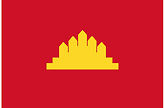
In Pjöngjang (평양, Nordkorea) gibt Norodom Sihanouk, Präsident der kambodschanischen Exilregierung der Mörderbanden der Roten Khmer (ខ្មែរក្រហម), seinen vorläufig auf ein Jahr begrenzten Rücktritt bekannt. Als Grund gibt er an, dass Rote Khmer seine eigene Nationalarmee angegriffen haben.
Abb.: Lage von Pjöngjang (평양, Nordkorea)
[Bildquelle: OpenStreetMap. -- Creative Commons Lizenz (Namensnennung, share alike)]
1987-05-20

Tod des evangelikalen Missionars Boon Mark Gittisarn (กิติสาร, geb. 1898).
"Boon Mark Gittisarn (1898-1987) Boon Mark is one of the most important figures in 20th century Thai Protestant history. He was born in Rat Buri on 1 September 1898 and graduated from the Bangkok Christian College (BCC) in 1921. He converted to Christianity while at BCC. In 1923, he married Muan Suphaphun. After graduation, he became an American Presbyterian Mission evangelist in the Pitsanuloke Station. He graduated from McGilvary Theological Seminary in 1930, and in 1933 he became station evangelist for the Presbyterian Bangkok Station. The first General Assembly of the Church of Christ in Thailand (CCT), April 1934, elected him Assistant General Secretary, and in August 1934, he was installed as Pastor of Second Church, Bangkok. In 1938-1939, he was the translator for the controversial Chinese revivalist, Dr. John Sung and became Sung's most outspoken supporter. The CCT elected him General Secretary in 1938. During World War II Boon Mark traveled extensively encouraging CCT churches and helping them withstand pressure and oppression; after the War, however, Boon Mark left the CCT in 1948 and became associated with the founding and early development of Pentecostalism in Thailand. In 1957, he founded Thailand's first independent church, Bangkok Church, and he also founded the independent "Association of Free Churches" with himself as General Secretary. He played a central role in the evangelistic campaign of the American Pentecostal preacher, T. L. Osborn, in Bangkok in 1956. He subsequently associated himself with the United Pentecostal Church (UPC), an American group. Although the UPC in Thailand experienced significant growth at first, it declined rapidly when he withdrew from active leadership in the late 1960s. He then remarried and joined the Seventh Day Adventist Church. Boon Mark died 20 May 1987."
[Quelle: Dictionary of Thai Christianity. -- http://www.herbswanson.com/dictionary.php. -- Zugriff am 2013-10-05]
1987-05-26 - 1991-08-31

William H. Webster (1924 - ) ist Direktor des CIA.
Abb.: William H. Webster
[Bildquelle: FBI / Wikipedia. -- Public domain]
1987-06-07

Bangkok: Tod von John Blofeld (1913 - 1987)
"John Eaton Calthorpe Blofeld (Born Anthony, 2 April 1913 – 7 June 1987) was a British writer on Asian thought and religion, especially Taoism (道教) and Chinese Buddhism. Early life
Blofeld was born in London in 1913.[1] In his youth, he happened to come across a small statue of Gautama Buddha and, without knowing what it was, he felt a great passion to possess it, and then privately offered it flowers and prostrated before it every night. Experiences like this led Blofeld to believe in reincarnation, and that he had been a Buddhist in China in a previous life.[2] He was educated at Haileybury College, then Downing College, Cambridge University where he read natural sciences but did not complete his degree. Instead he left in his second year for travels to China.[3] From 1932 to 1935 he lived in Hong Kong [香港], teaching English at the Munsang College [民生書院] at Kai Tak Bun, Kowloon City [九龍城] and learning Cantonese [廣東話].[4] Then in the summer of 1935, he moved to China, having obtained a teaching position at the Hebei [河北] Academy of Industry in Tianjin [天津], with a teaching schedule that would allow him to spend three nights a week in Beijing [北京].[5] Family matters called him back to England in the summer of 1937, so he was not present when the Japanese occupied northern China.
War years and afterReturning to Hong Kong in September 1937, he mostly resided in and traveled around China until 1949, visiting monasteries and all the sacred mountains[6] and talking to Mongolian lamas, Zen (禪;) masters, Taoist sages, and others. He lived for some time in Peking, and traveled through Asia (Tibet, Mongolia, China, India, and Burma) to visit the places where those religions lived within their practitioners. He talked to Taoist eremites (hermits), spent time in monasteries and experienced how alive the spiritual culture of China was in this period. Blofeld became a pupil of Hsu Yun (虚云, 1840 - 1949) but actually received training in Chan (Zen) meditation from Hsu Yun's pupils at a monastery near Kunming (昆明), Yunnan (云南). He also received Vajrayana teachings.
Starting in 1937, he traveled around south China and southeast Asia, visiting Guilin (桂林),[7] Hanoi (Hà Nội),[8] Kunming (where he spent ten months meditating in the Hua Ting monastery),[9] and eventually returned to Hong Kong to resume teaching at the Min Sheng Academy. But after several months there, he returned to England in 1939, to enroll in the School of Oriental and African Studies at the University of London, where he studied Chinese, Japanese, Korean, and Malaysian. His academic studies were again interrupted, this time by World War II. After one year of studies, he enlisted in counterintelligence (otherwise he would have been conscripted without a choice of which service to enter), and was soon promoted and sent to the British Embassy in Chongqing (重庆) as cultural attache, on the basis of his proficiency in Chinese.[10]
When the war ended, Blofeld returned to England and, in six months, earned a master's degree in literature at the University of Cambridge. In 1946, he flew to Hebei. He had a Chinese National Government grant to study Tang Dynasty (唐朝) Buddhism, and taught English at Shi Fan University.[11]
Seeing that a Communist takeover was imminent, Blofeld fled Beijing with his pregnant wife.[12] He then taught English in Hong Kong (1949-1951) and Chulalongkorn University (จุฬาลงกรณ์มหาวิทยาลัย) in Bangkok (1951-1961).[13] During these years he also visited Darjeeling (দার্জিলিং) to study with Nyingma (རྙིང་མ་) teachers including Dudjom Rinpoche (བདུད་འཇོམས་འཇིགས་བྲལ་ཡེ་ཤེས་རྡོ་རྗེ།, 1904 - 1987) and Dodrupchen Rinpoche.
Blofeld worked for the United Nations (ECAFE, later ESCAP - Economic and Social Commission for Asia and the Pacific) (1961-1974), and then retired.[14] In his later years, he conducted extensive lecture tours of America and Canada (1978-1980), and subsequently studied Chinese composition and literature.
His studies and his collected experiences with the sages and mystics of China are of special interest, because he entered this realm in an era before the Cultural Revolution (无产阶级文化大革命) which aimed at annihilating all ties to the old feudal Chinese identity.
His own view on the practices and beliefs he encountered was always marked by admiration of this lived spirituality. In the beginnings of his travels and studies, he was not very familiar with the native languages, and held a skeptical position against the shamanistic elements of those religions. But as his studies dove deeper into the complex symbolism of Asian thought, he developed a broader view, and became himself a deeply spiritual man. Blofeld mentored Red Pine (赤松 = Bill Porter, 1943 - ) in his translation work. According to Red Pine, Blofeld "was a very sincere Buddhist who practiced every night for several hours and loved what he did. I don't think he ever stopped learning."[15]
Personal lifeAt age 34, Blofeld married Change Mei-fang, of whom he wrote, "She was half Manchu and half Chinese ... She was a woman of excellent character, intelligent and capable, but she was extremely argumentative! This goes to show that the old saying, 'Heaven punishes the guilty', is not just an empty slogan."[16]
His first child was a son, named Ming Deh ("Bright Virtue"), born in Hong Kong the year he fled the Communist takeover of Beijing. A year later, his daughter, Shueh Chan ("Snow Beauty") was born.[17]
He died of cancer at age 74 in Bangkok, Thailand. His ashes occupy a place of honor in a Chinese Guan Yin (觀音菩薩) temple he had helped build in 1951.[18]
He left a son and daughter who currently reside in Spain and Chesham. He has four granddaughters and a grandson."
[Quelle: https://en.wikipedia.org/wiki/John_Blofeld. -- Zugriff am 2016-03-23]
1987-06-10

Interview des Foreign Correspondents Club of Thailand mit Kronprinz Vajiralongkorn (พลเอก พลเรือเอก พลอากาศเอก สมเด็จพระบรมโอรสาธิราช เจ้าฟ้ามหาวชิราลงกรณ บดินทรเทพวรางกูร สิริกิติยสมบูรณสวางควัฒน์ วรขัตติยราชสันตติวงศ์ มหิดลพงศอดุลยเดช จักรีนเรศยุพราชวิสุทธ สยามมกุฎราชกุมาร, 1952 - )
Der Kronprinz sagt u.a.:
"As for me, I have lots more to learn, lots more to improve in every field. And I must stress again there is lots more to learn, lots more happy and unhappy occasions to face - and that is life."
1987-06-26

USA: Premiere des britisch-US Antikriegsfilms Full Metal Jacket von Stanley Kubrick (1928 - 1999).
Abb.: ©Plakat
[Bildquelle: Wikipedia. -- Fair use]
Abb.: Vollmantelgeschosse (full metal jacket bullet)
[Bildquelle: DL24 / Wikipedia. -- Public domain]
"Full Metal Jacket ist ein britisch-amerikanischer Antikriegsfilm aus dem Jahr 1987 und eines der letzten Werke von Stanley Kubrick. Der Name Full Metal Jacket bezieht sich auf die englischsprachige Bezeichnung für das Vollmantelgeschoss (full metal jacket bullet). Der gesamte Film, der unter anderem in einem Ausbildungslager der US-Marines und in Vietnam spielt, wurde in der Umgebung von London gedreht. Zur Ergänzung wurden lediglich Archivmaterial und eine Luftaufnahme eingearbeitet. Der auf den Romanen The Short-Timers (deutscher Titel: Höllenfeuer) und Dispatches (deutscher Titel: An die Hölle verraten) basierende Film schildert in zwei Abschnitten die Ausbildung einer Gruppe von Marines und ihren anschließenden Einsatz in Vietnam."
[Quelle: http://de.wikipedia.org/wiki/Full_Metal_Jacket. -- Zugriff am 2013-10-12]
1987-07
Im Polizeispital gelingt die Transplantation eines Penis von einem Mann, der eine Sexumwandlung will, auf einen Mann, dem seine Frau den Penis abgeschnitten hat. Die Operation dauert 7 Stunden.
1987-07-07
Die Regierung schlägt eine Änderung des Condominium Acts vor. Danach sollen Ausländer bis zu 25% Eigner eines Condominium werden.
1987-07-15
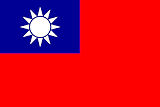
In der Republik China (中華民國, Taiwan) wird das seit 1949-05-19 bestehende Kriegsrecht aufgehoben.
Abb.: Lage der Republik China (中華民國, Taiwan)
[Bildquelle: CIA. -- Public domain]
1987-07-28

Chirayu Isarangkul na Ayutthaya (นายจิรายุ อิศรางกูร ณ อยุธยา, 1942 - ) wird Direktor des Crown Property Bureau (สำนักงานทรัพย์สินส่วนพระมหากษัตริย์). Chirayu wird auch Great Chamberlain (stellvertretender Genralsekretär) des Office of the Royal Household Bureau (สำนักพระราชวัง). Der bisherige Amtsinhaber, Keokhwan Vajarodaya (แก้วขวัญ วัชโรทัย, 1928 - ), wird Lord Chamberlain.
Abb.: Chirayu Isarangkul na Ayutthaya (นายจิรายุ อิศรางกูร ณ อยุธยา)
[Bildquelle: th.Wikipedia. -- Fair use]
Abb.: Keokhwan Vajarodaya (แก้วขวัญ วัชโรทัย)
[Bildquelle: th.Wikipedia. -- Fair use]
1987-08-07
Der Mediziner Dr. Aree Valyasevi (อารี วัลยะเสวี, 1925 - ) erhält in Manila den Ramon Magsaysay Award for Community Leadership.
Abb.: ®Ramon Magsaysay Award
[Bildquelle: Wikipedia. -- Fair use]
Abb.: Lage von Manila
[Bildquelle: OpenStreetMap. -- Creative Commons Lizenz (Namensnennung, share alike)]
Abb.: Aree Valyasevi (อารี วัลยะเสวี)
[Bildquelle: http://www.rmaf.org.ph/Awardees/Citation/CitationValyaseviAre.htm. -- Zugriff am 2011-12-10. -- Fair use]
"More than a billion young people today begin life crippled by poor diets. Even in Thailand, which exports food, more than half of all infants and preschool children suffered from malnutrition as recently as 1980. Lacking healthy bodies and alert minds, malnourished children reinforce the tenacious cycle of ignorance and poverty. As a medical scientist Dr. AREE VALYASEVI has investigated this vexing problem for 27 years.
AREE received his medical education at Siriraj Hospital Medical College (คณะแพทยศาสตร์ศิริราชพยาบาล) in Bangkok and subsequently studied advanced paediatrics and nutrition at the University of Pennsylvania in the United States. He first became aware of the deficient health and diets of rural Thais while conducting a countrywide nutritional survey in 1960. What he saw prompted him to abandon his newly begun private practice to pursue research devoted to rural public health.
Intrigued by the high incidence among poor children in northeast Thailand of painful and debilitating bladder stone disease, AREE traced the cause to minerally imbalanced diets, combined with mild dehydration induced by heat, chronic diarrhoea, vomiting and fever. He found that phosphate-rich dietary supplements could reduce bladder stone formation. This preventive measure is now used in other countries where bladder stone disease is prevalent.
From 1976 AREE tackled protein-energy malnutrition (PEM), the most serious form of malnourishment among Thailand's rural children. With his colleagues and students at Mahidol University's (มหาวิทยาลัยมหิดล) Institute of Nutrition, which he helped found in 1976, AREE devised palatable protein energy-rich food mixes for infants. Made from locally available beans, sesame seeds and groundnuts, these mixes can be manufactured cheaply by the villagers themselves. When introduced in Nong Hai Village (หนองไฮ), his pilot site, the percentage of normal healthy children rose from 45 to 79 in eight months.
AREE discovered that it is "essential to integrate health care, agriculture and income generation into the nutritional package." The means of improvement, he adds, "must be in the villagers' own hands." His effective advocacy encouraged adoption by the Ministry of Health of integrated, community-based nutritional programs in Thailand. Since 1981 such programs have been incorporated into national development plans and introduced, along with AREE'S food mixes, to some 12,500 villages. The incidence of PEM has declined by half, and third-degree malnutrition, the severest level of malnutrition, is 62 times rarer today than 10 years ago.
A colleague describes 61-year-old AREE as a visionary who "works, works, works." Aside from research and teaching he has authored or co-authored several medical textbooks and more than 78 scientific papers, and has served on numerous commissions and agencies. As Founding Dean of Ramathibodi Medical School (1968 to 1977) (คณะแพทยศาสตร์โรงพยาบาลรามาธิบดี), AREE introduced a comprehensive course on community health. His internationally respected curriculum emphasizes disease prevention and requires medical students to learn techniques of community diagnosis and planning. It also encourages young doctors to stay in rural practice following the two years the government requires of them. Some one third of Ramathibodi's graduates have done so, giving Thailand, with AREE's guidance, a new generation of doctors for a new generation of healthier children.
In electing Dr. AREE VALYASEVI to receive the 1987 Ramon Magsaysay Award for Community Leadership, the Board of Trustees recognizes his contribution in improving the diets and promoting the good health of millions of Thai children."[Quelle: http://www.rmaf.org.ph/Awardees/Citation/CitationValyaseviAre.htm. -- Zugriff am 2011-12-10]
1987-08-08
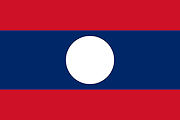
Ca. 200 Pathet Lao (ປະເທດລາວ) Soldaten greifen Soldaten bei Ban Rom Klao (บ้านร่มเกล้า), Provinz Phitsanulok (พิษณุโลก), in der Nähe einer umstrittenen Grenze zu Laos an und erzwingen die Räumung des Dorfs. Laos beansprucht das Dorf und den Berg Phu Soi Dao (ภูสอยดาว). Thailand verstärkt seine Truppen mit Thahan Phran (ทหารพราน, Rangers) und Volunteer Defence Corps (Or Sor) (อส. = กองอาสารักษาดินแดน). Die Kämpfe dauern monatelang an.
Abb.: Lage von Ban Rom Klao (บ้านร่มเกล้า)
[Bildquelle: OpenStreetMap. -- Creative Commons Lizenz (Namensnennung, share alike)]
Abb.: Phu Soi Dao (ภูสอยดาว)
[Bildquelle: ©Google earth. -- Zugriff am 2011-12-10]
1987-08-15
Bangkok Post über die Anti-AIDS-Kampagne in der Presse:
"The Thai-language press yesterday stepped up its campaign against AIDS as reports indicated that there may be many more carriers of the deadly disease than earlier believed. Daily News [เดลินิวส์] ran an editorial calling on the Government to prevent the spread of AIDS by controlling homosexuality in the country. The paper implied it might be necessary to declare homosexuality a crime punishable by law. This would help bring down the number of gays and thus prevent the spread of AIDS, it said.
Thai Rath [ไทยรัฐ]meanwhile reported that Mukdahan [มุกดาหาร] provincial authorities had launched a publicity campaign against AIDS. The move followed a revelation that a schoolteacher in the province had contracted the disease and might have passed the virus on to his sex partners. The paper also quoted a doctor as saying that the teacher was in fact a bisexual, which means that some women might have contracted the disease as well.
Abb.: Lage von Mukdahan [มุกดาหาร]
[Bildquelle: CIA. -- Public domain]Thai Rath said the teacher was believed to have had sexual relations with about 25-30 people.
As the AIDS campaign got under way, the gay community In Mukdahan was keeping a low profile. Some said they feared they would be attacked by the local people, the paper said. According to Thai Rath, there are about 30 homosexuals in Mukdahan."
[Zitiert in: Jackson, Peter A. <1956 - >: Dear Uncle Go : male homosexuality in Thailand : สวัสดีกรับ อาโก๋ ปากน้ำ. -- Bangkok : Bua Luang, 1995. -- 310 S. : Ill. ; 21 cm. -- ISBN 0942777115. -- Völlige Neubearbeitung von Ders.: Male homosexuality in Thailand : an interpretation of contemporary Thai sources (1989). -- S. 283]
1987-08-23
Die Regenmacher-Raketen Pirun I und Pirun II stehen angeblich in der letzten Entwicklungsphase.
1987-08-25
Es erscheint die letzte Nummer der Abendzeitung Bangkok World
Abb.: Bangkok World, 1987-08-25
[Fair use]
1987-08-30


Der thailändische Geheimdienst enttarnt zwei Spione der Sowjetunion. Einer davon ist ein gebürtiger Tscheche mit deutscher Staatsbürgerschaft.
Abb.: Sowjetunion
[Bildquelle: Wikipedia. -- Public domain]
1987-09


Der Kronprinz ist auf Staatsbesuch in Japan. Über sein Verhalten dort berichtet Barbara Crosette in der New York Times unter dem Titel "Once upon a time a good King had 4 children ..." am 1987-12-15:
"The Crown Prince in Japan ''Sometimes,'' he replied, ''black sheep serve a purpose, one of helping others. Black sheep help those not-too-white ones seems whiter.''
In September, a diplomatic storm blew up between Tokyo and Bangkok over what Thai-language newspapers reported as ''slights'' to the Crown Prince, a pilot and army major general who commands his own regiment, during an official visit to Japan.
A Japanese chauffeur driving the Thai Prince's car apparently stopped at a motorway tollbooth to relieve himself - Japanese officials say the man felt ill and had to be replaced. On other occasions, the Prince was said to have been given an inappropriate chair to sit on and to have been forced to reach down to the floor to pick up a cord to unveil a memorial."
[Fair use]
1987-09

Japanisches Ayutthaya Historical Study Center Projekt
"The Ayutthaya Historical Study Center project is one of the best-known Japanese grant aid projects in Thailand. An extensive literature has developed around it. The extant literature, however, focuses largely on concerns of Japanese cultural insensitivity, Japanese private sector domination of the Thai economy, and political bungling by the Japanese government. While the project’s history allows us to observe these factors, it also allows us a chance to observe the process of accommodation in the aid relationship. In particular, it reinforces the conclusion in the Twelfth Yen Loan case that limiting the number of participants makes project negotiation easier. The impetus for the project originally came from the Bangkok Japanese Chamber of Commerce. In 1984 that organization’s tourist bureau began to talk of restoring the site of a seventeenth century Japanese trading community that had existed in the then-capital of Siam at Ayutthaya [พระนครศรีอยุธยา]. The Japanese embassy subsequently adopted the idea as a project to commemorate the upcoming centennial of Thai-Japanese diplomatic relations in 1987, and approached the Ayutthaya provincial government and the Thai Ministry of the Interior. Following negotiations, Japan and Thailand agreed to a grant aid project amounting to 999 million yen. Prime Minister Nakasone [Nakasone Yasuhiro / 中曽根 康弘, 1918 - ] was to inaugurate the project during his state visit to Thailand in late September 1987 to celebrate the centennial.
Thai actors subsequently initiated two sets of revisions. The first followed expressions of dissatisfaction from Thai architects. In early September 1987, the Association of Siamese Architects (ASA) [สมาคมสถาปนิกสยามฯ] submitted a letter to the Thai foreign minister protesting the planned construction of the facility. The ASA argued that Thai nationals should participate in the project’s building and landscape design, a responsibility that theretofore rested solely with the Thai-Japanese Association, which owned the land on which the center was to be built. It also argued that Japan’s contribution to Thai history in the Ayutthaya period was minimal, and maintained further that employment of Japanese contractors and construction crews at the site was illegal. A week later it demanded in a letter to the foreign ministry that Thai contractors and architects receive a 70 percent share of the project work. The ASA’s protest had two results. The first was to derail the diplomatic effect of the center’s inauguration. Following the ASA’s first letter of protest, the project’s chairman, a former minister of finance, cancelled his scheduled trip to Japan in mid-September. In mid-month, the Thai and Japanese governments agreed to cancel Prime Minister Nakasone’s inauguration of the Center.
The second result was that Thai architects gained a participatory role in the project design. Initially, JICA [Japan International Cooperation Agency / 独立行政法人国際協力機構] had insisted that the design be carried out by Japanese architects, with Thai architects to be consulted on the building specifications. Following the cancellation of Nakasone’s visit to the Center, Japan agreed in principle to try to allow Thais a major share in the project’s construction and design. It sent a team to Thailand in October to discuss the design with Thai architects. Discussions continued through the winter and spring. In the summer of 1988 the Ministry of Interior’s committee delivered an ultimatum that the architectural work be done by Thais, to which the Japanese agreed. The final design was significantly altered to include Thai design elements, and Thai contractors won 70 percent of the project’s work. One JICA official commented that it was the first time a JICA basic design study had been radically changed.
The second revision occurred four months after the center’s inauguration. In late January 1988 the Ministry of Interior requested that the project site be moved from its original location at the former Japanese village to a location in front of the Ayutthaya provincial office. JICA demurred, arguing that there was no precedent for moving a site following the completion of the basic design, but the move was eventually carried out.
The Ayutthaya case is interesting because it is one of a very few cases in which nongovernmental actors have been able to effect a change in a Japanese aid project that had already been agreed upon. The ASA’s effectiveness in convincing Japan to let it participate in the project was undoubtedly due to the political climate in Thailand at the time. ASA’s objections to the Ayutthaya project were part of a larger concern about the presence of Japanese companies in Thailand. The provision of the Ayutthaya grant took place in an era of Japanese private sector expansion in the country. Thai companies were dissatisfied with the growing Japanese presence because they saw their foreign counterparts as taking away business from local firms. The suspicion that Japanese companies enjoyed undue influence in gaining aid contracts further reinforced the dissatisfaction. The completion of the Thailand Cultural Center project in early 1987 under a JICA grant particularly galled associations like the ASA, which saw the non-Thai design of the buildings as out of keeping with local aesthetics. By 1987 the major Thai construction and engineering associations, including the ASA, had begun to discuss ways of dealing with the competition from outside.
ASA’s position was undoubtedly strengthened by the public nature of the debate over the Ayutthaya project. ASA had already expressed its objections to JICA procurement and contracting procedures earlier in the year in its own journal. The anticipated arrival of the Japanese prime minister for the groundbreaking ceremony created an opportunity for the ASA to take its case to a wider audience. Its objections were carried in Thai newspapers, transforming an industry concern into a foreign policy issue. The wide media coverage of the project created an anticlimax for the centennial ceremonies.
It is important to understand what the Ayutthaya project does not represent. The negotiations were about modifying the project, not cancelling it. The ASA succeeded in pressing its demands that the project be reformulated to include meaningful Thai input. Cancelling the project was probably beyond the ASA’s reach, although there were fears it might happen. The project’s allies in Thailand included the Thai-Japanese Association (under whose auspices the project was originally to have been carried out), the Thai Ministry of Foreign Affairs, and the Ministry of Interior. The latter two were in positions to make authoritative decisions about the project, a position the ASA and its allies in the private sector did not enjoy. Cancellation of the project, moreover, would have risked souring relations between the two governments, a high price for the Thai government to have to pay for the sake of one domestic interest group. We see the shadow of the future constraining unilateral Thai decisions in the aid relationship and limiting the number of effective players.
Resolution of the Ayutthaya grant problem was possible because it was isolated from the rest of the aid program. The Thai construction industry’s ire was concentrated on Ayutthaya, and did not spill over into other project negotiations. Indeed, given the furor over Japan’s rules for contracting and procurement, it is interesting that the negotiations for the Thirteenth Yen Loan were completed within a week without a hitch. Containment of the issue was undoubtedly helped by the lack of program coordination between JICA and the OECF [Overseas Economic Cooperation Fund / 海外経済協力基金]. The isolation of the Ayutthaya project prevented disagreement from endangering other parts of the aid relationship and, therefore, from threatening bilateral cooperation. Moreover, despite JICA concessions, grant aid procurement practices overall changed little, and there is no evidence that the ASA continues to play an active part in determining Thai priorities in the bilateral aid relationship."
[Quelle: Potter, David M. <1961 - >: Japan's foreign aid to Thailand and the Philippines. -- New York : St. Martin's, 1996. -- 206 S. : Ill. ; 22 cm. -- ISBN 0-312-12563-1. -- S. 142ff. -- Faire use]
1987-09 - 2003-07

Die Bundesrepublik Deutschland fördert das Environment Advisory for Industry Project
1987-09-06


Toledo Blade (USA): Power and awe surround royal family / von Ben Barber
"There is no criticism and nothing about their personal lives. Millions of tourists have been drawn here for "Visit Thailand Year," a celebration of the king’s fifth 12-year cycle.
But few visitors may realize how seriously the Thais take their king.
"When the royal household calls the editor and says, ‘There’s a picture’ we run it willingly," said a leading Thai journalist. "It perpetuates one of the main pillars of society. The country could be in a lot of trouble without it."
Thongbai Thongpao [ทองใบ ทองเปาด์, 1926 - 2011], a leading
human rights attorney who has defended many lèse majesté victims, says: "The king is above any criticism - the king is above everything," and to even ask in a survey or a newspaper article if people still want the king is "dangerous."Revered former Prime Minister M.R.
Kukrit Pramoj [พลตรี หม่อมราชวงศ์คึกฤทธิ์ ปราโมช, 1911 - 1995] worried that the lèse majesté charges are misused. "It’s a good thing to show one’s loyalty but we are beginning to make too much use of it," he said. "We cannot say that we are more loyal than someone else. Everyone has benefited from the king and feels loyal to him. Those who were accused of lèse majesté] were not little people,They were people whose behaviour has never
been tarnished and who are often in high places in government." Kukrit warned that some use the disloyalty charge to destroy those they oppose."
1987-10
Amnestie Muslim Santi (มุสลิมสันติ, Muslim Frieden) für Rebellen der vier muslimisch-malaiischen Südprovinzen. In der Folge legen bis Januar 1988 641 Aufständische die Waffen nieder und schwören Loyalität zu Thailand.
1987-10-09

Als Teil der Feierlichkeiten zum 60. Geburtstag des Königs wird das Thailand Cultural Centre (ศูนย์วัฒนธรรมแห่งประเทศไทย) in Bangkok eröffnet.
Abb.: Thailand Cultural Centre (ศูนย์วัฒนธรรมแห่งประเทศไทย), Bangkok, 2009
[Bildquelle: Vee Satayamas. -- http://www.flickr.com/photos/vscript/3641884160/. -- Zugriff am 2012-04-04. -- Creative Commons Lizenz (Namensnennung, keine kommerzielle Nutzung, keine Bearbeitung)]
Abb.: Lage des Thailand Cultural Centre (ศูนย์วัฒนธรรมแห่งประเทศไทย), Bangkok
[Bildquelle: OpenStreetMap. -- Creative Commons Lizenz (Namensnennung, share alike)]
"Thailand Cultural Centre (Thai ศูนย์วัฒนธรรมแห่งประเทศไทย) is a performing-arts venue in Bangkok, Thailand. History
Built with a grant from Japan, the Thailand Cultural Centre opened on October 9, 1987 as part of celebrations for King Bhumibol's 60th birthday.[1]
FacilitiesThe venue consists of two auditoriums and one outdoor stage and is used for various live performances all year round. The Main Hall is a 2,000-seat auditorium, and is used for stage presentations, concerts and conferences. The Small Hall is a 500-seat multi-purpose auditorium, which is integrated with a 1,000-seat outdoor amphitheater. The Social Education and Exhibition Building accommodates a cultural library and the Thai Life Permanent Exhibition. There is also the Japanese Pavilion and the Thai Pavilion.
The main Thai Life exhibition was closed until July 2011 for re-organisation and development.
LocationThe venue is located on Ratchadaphisek Road (ถนนรัชดาภิเษก), close to the junction with Tiam Ruammitr Road, in Huai Khwang district (ห้วยขวาง)."
[Quelle: http://en.wikipedia.org/wiki/Thailand_Cultural_Centre. -- Zugriff am 2012-04-04]
1987-10-13
Die Regierung beschließt, dass Ausländer mit HIV keine Einreisegenehmigung bekommen und dass Gefangene mit HIV von der Amnestie am Geburtstag des Königs ausgeschlossen sind. Ein Arzt macht den Namen eines Model und angeblichen Prostituierten mit AIDS öffentlich bekannt. Die Frau kann in einer Pressekonferenz eine Diagnose vorweisen, dass sie HIV-negativ ist.
1987-10-25
Der Filmschauspieler Sombat Metanee (สมบัติ เมทะนี, 1937 - ) schafft es ins Guiness Book of World Records, nachdem er in 600 Filmen aufgetreten ist.
Abb.: Sombat Metanee (สมบัติ เมทะนี) (links)
[Bildquelle: th.Wikipedia. -- Fair use]
"Sombat Metanee (Thai: สมบัติ เมทะนี, born June 26, 1937 in Ubon Ratchathani Province (อุบลราชธานี), Thailand) is a Thai actor and film director. At one time he held the Guinness World Record for most film appearances (more than 600). By his own count, he's made more than 2,000 films and television shows, including lakorns (ละคร, Thai soap operas). A prolific leading man in action films, romance, dramas, comedies and musicals at the height of his career in the 1960s and '70s, he continues to act in Thai films and in television series, making frequent appearances on talk shows and in TV commercials. Among his recent films are Tears of the Black Tiger (ฟ้าทะลายโจร) and The Legend of Suriyothai (สุริโยไท). Biography Early films
Sombat was introduced to the show business in 1960 by Namdee Witta, the leader of a television performance troupe. He starred in the television series, "Hua Jai Pratana" (หัวใจปรารถนา, "Heart's Desires").
His physical attractiveness caught the eye of Noi Kamolwatin, a film director from the Kamolsilpa Pappayon studio. Noi cast Sombat in Roong Petch (รุ้งเพชร, Diamond Rainbow), which opened at the Empire Theatre in Bangkok and became a huge success. With a fine-sculpted body, brawny face and slicked-back, pomaded hair, Sombat was a popular leading man, with both men and woman writing him fan letters. "I never thought of acting, but I was good-looking, smart; I had sex appeal," Sombat said in 2006 in an interview with ThaiDay.[1]
Sombat went on to star in four more Kamolsilpa Pappyon films: Skao Duen in 1962 and Singh Sang Pa (สิงห์สั่งป่า), Saming Sao and Nagm-Ngon, all released in 1963. He was then picked up by director Tawee Na Bangchang (better known as Kru Marut) to star in Tawan Lang Lued (ตะวันหลั่งเลือด , Blood of the Sun). He also appeared in Kao Mangkorn (เก้ามังกร, Nine Dragons), directed by Warun Chatrakul Na Ayutthaya. He was cast by his old talent scout, Namdee Witta, in the action film Singh La Singh (The Lion vs The Lion), in which he co-starred with Mitr Chaibancha (มิตร ชัยบัญชา), who was Thailand's top leading man at the time.
Top leading manOften performing his own stunts, Sombat was an action star very much in the same mold as Mitr Chaibancha. And after Mitr's accidental death in 1970, Sombat became the top Thai leading man, often sharing the screen with Mitr's frequent co-star, Petchara Chaowarat (เพชรา เชาวราษฎร์), such as the 1971 musical comedy, Ai Tui (ไอ้ทุย, Mr. Tui), directed by Dokdin Kanyamarn. He was mainly paired with Aranya Namwong (อรัญญา นามวงศ์), though, and they replaced Mitr and Petchara as Thailand's top screen couple.
In 1966, Sombat won a "Golden Doll", Thailand's equivalent at the time to the Academy Award, for best actor in Suek Bang Rajan (ศึกบางระจัน,The Battle of Bang Rajan). He received the statuette from King Bhumibol himself.
In 1973, he established Metanee Film, which lasted five years and made 23 films. Among them was the action-comedy Nak Leng Tewada (นักเลงเทวดา,The Holy Hoodlum) in 1975.
Other films from the 1970s include the violent prison drama, Narok Tarutao (นรกตะรุเตา,The Hell of Tarutao), directed by Ruj Ronaphop, and the historical epic, Khun Suk (ขุนศึก, War Lord), directed by Sakka Jarujinda. He played a cowboy in The Reluctant Gunman (Mue Peun Khia), a gangster in Louie, romanced Aranya Namwong in Chain of Love, was the Man With a Thousand Masks and controlled robot assassins in Nak Leng Computer (Gangster Computer). In another film, 1976's Choompae, he portrayed a brutal anti-hero.
Recent workWith age, Sombat graduated away from the hero roles, playing the role of the heavy. He was the leading villain in the 2000 Thai western, Tears of the Black Tiger (ฟ้าทะลายโจร), a film that paid homage to the action films he starred in during the 1960s and '70s.
In addition to Tears of the Black Tiger, he was among an all-star Thai cast in Chatrichalerm Yukol's (หม่อมเจ้าชาตรีเฉลิม ยุคล) The Legend of Suriyothai (สุริโยไท). He had a small comedic role in the 2004 comedy, Bangkok Loco (ทวารยังหวานอยู่) and played a senior police officer in the 2005 horror-comedy, Buppah Rahtree Phase 2: Rahtree Returns (บุปผาราตรี เฟส 2).
He's a frequent fixture on Thai television talk shows and in 2006 was appearing in a TV commercial for a brand of DVD player, spoofing his action roles of the 1970s.
In 2004, a restored print of Ai Tui (ไอ้ทุย, Mr. Tui), the 1971 musical comedy he starred in with Petchara Chaowarat was screened at the 2nd World Film Festival of Bangkok. Sombat was honored at the 2006 Bangkok International Film Festival with a Lifetime Achievement Award. The festival's program included a career-spanning retrospective of five of his films: Blood of the Sun from the 1960s, The Holy Hoodlum, Narok Tarutao and War Lord from the 1970s and 2000s Tears of the Black Tiger.[2]
Singing career, familyPossessing a natural singing voice, Sombat has recorded some 200 songs and released many movie soundtrack records and albums, including 1981's Sombat Kong Yow. He's also penned an autobiography, which was released in 1994.
His wife's name is Karnjana. She managed his film company. His oldest son Siricoup starred in Chatrichalerm Yukol's 1993 film Salween and is now a race-car driver.
Political careerIn the April 19, 2006 Senate election, Sombat Metanee was elected to a six-year term in the Senate, serving as a representative from Bangkok. He earned 53,562 votes,[3] though his term was cut short by the 2006 Thailand coup. Of his decision to run, Sombat, who is popularly known by his nickname, Ad, said: "If Arnold Schwarzenegger won votes to be governor in America, why can’t Uncle Ad do something good for Thailand by being elected Senator?" [4]
In Thailand, candidates for political office are required to have a university degree, so between film shoots, Sombat returned to school to pursue an education. He has a Bachelor of Arts from Rajabhat Walailongkorn University, a Master of Public Administration from Eastern Asia University and is working on a Ph.D in Public Administration."
[Bildquelle: http://en.wikipedia.org/wiki/Sombat_Metanee. -- Zugriff am 2011-12-10]
1987-10-28
Oudomxay (ອຸດົມໄຊ, Laos): Tod des kommunistischen Schriftstellers und Staatsanwalts Atsani Phonlajan (อัศนี พลจันทร, 1918 - 1987, aka Nai Phi - นายผี).
Sein berühmtestes Gedicht ist "Isaan" (der Nordosten - อิศาน). Daraus die drei letzten Verse:
ในฟ้าบ่มีน้ำ
น้ำตาที่ตกรายสองมือเฮามีแฮง
สงสารอีศานสิ้นพายุยิ่งพัดอื้อ
อีศานนับแสนแสนในดินซ้ำมีแต่ทราย
คือเลือดหลั่ง! ลง โลมดินเสียงเฮาแย้งมีคนยิน
อย่าซุด, สู้ด้วยสองแขน!ราวป่าหรือราบทั้งแดน
สิจะพ่ายผู้ใดเหนอ?Vertrocknet der Himmel, verdorrt, die
Erde Sand nur und Sand.Es fließen, liebkosend das Land,
die Tränen wie blutiges Leid.Doch Kraft ist in Nacken und Faust!
Man hört euch, wenn zornig ihr schreit.
Steh stark du, Nordosten, im Streit,
wir mit dir — drum wanke du nicht.Verdunkeln wird tosender Sturm
der Fluren und Wildnisse Sicht,
wenn Volk zu viel Tausenden bricht
hervor — wer hielte ihm stand?
[Übersetzung: Wenn vom Tau der Reis erwacht : eine Auswahl thailändischer Lyrik von früher Zeit bis heute / hrsg. übers. von Volkmar Zühlsdorff [1912 - 2006]. -- München : Simon und Magiera, 1984. -- 87 S. : Ill. ; 21 cm. -- (Der andere Literaturklub). -- ISBN 3-88676-018-9. -- S. 44. -- Fair use]
1987-10-31
Dr. Boonthiam (บุญเทียม) von der Thai Citizen Party (พรรคประชากรไทย) bringt das reformierte, 19981 am Senat gescheiterte reformierte Abtreibungsgesetz nochmals in die Gesetzgebung.
1987-11-01

Malayan Railways schließen den Personenzugverkehr Arau - Padang Besar. Grund: ständiger Schmuggel von Reis aus Thailand nach Malaysia.
Abb.: Lage von Arau und Padang Besar
[Bildquelle: OpenStreetMap. -- Creative Commons Lizenz (Namensnennung, share alike)]
1987-11-23

Phillip C. Clark beantragt das US-Patent für "Method for converting one or more steel shipping containers into a habitable building at a building site and the product thereof". Damit beginnt die Shipping container architecture (Container-Architektur). Sie wird später auch in Thailand angewandt werden.
1987-11-25

Unter Tumult verabschiedet das Parlament das auf Druck der USA verfasste Copyright-Gesetz.
"Copyright law in Thailand governs the legally enforceable rights of creative and artistic works under the Copyright Act BE 2521 (1978), as amended. Copyright is automatically protected for 50 years and does not need registration, however it can be filed with the DIP. Disputes are first heard in the Intellectual Property and International Trade Court. [1][2] Copyright term
According to Thai copyright law, the copyright term is the life of author plus 50 years.[3] When the author is a legal entity or an anonymous person, the copyright term is 50 years from the date of publication. Works of applied art (defined as a work which takes a composition of works such as drawings, paintings, sculpture, prints, architecture, photography, drafts, and models for utility or functional use) have a copyright term of 25 years from publication.[4]
Public domainRepublication of works after the expiration of the copyright term does not reset the copyright term. Thai state documents are public domain,[5] though creative works produced by or commissioned by government offices are protected by copyright."
[Quelle: http://en.wikipedia.org/wiki/Copyright_law_of_Thailand. -- Zugriff am 2011-12-10]
1987-11-Ende
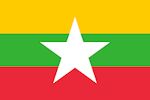
Myanmars Staatspräsident Ne Win (နေဝင်, 1911 - 2002) brinmgt als Geschenk zum 60. Geburtstag des Königs eine 60 cm hohen mit Rubinen besetzte Buddha-Statue aus Jade. Der Buddha war vom obersten Mönch Myanmars sowie weiteren 15 hochrangigen Mönchen gesegnet worden. Ne Win ist nur wenige Stunden in Thailand und wird von Prinzessin Sirindhorn (มหาจักรีสิรินธร, 1955 - ) betreut.
1987-12 - 1988-02

Thai–Laotian Border War (สมรภูมิบ้านร่มเกล้า / ยุทธการบ้านร่มเกล้า)
Abb.: Lage von Ban Romklao (บ้านร่มเกล้า)
[Bildquelle: OpenStreetMap. -- Creative Commons Lizenz (Namensnennung, share alike)]
Abb.: Noen 1428 (Hill no. 1428), the battlefield of Thai–Laotian Border War of 1988, view from Phu Soidao National (อุทยานแห่งชาติภูสอยดว) Park, Phitsanulok Province
[Bildquelle: Tevaprapas Makklay / Wikipedia. -- GNU FDLicense]
"The Thai–Laotian Border War (December 1987 – February 1988) was a short confrontation between Thai and Laotian forces. It was caused by a dispute involving the map made by French surveyors in 1907 to mark the borders between Siam and French Indochina in the southern Luang Prabang Range mountain area. Ownership of the village of Ban Romklao (บ้านร่มเกล้า) on the border of Phitsanulok Province (พิษณุโลก) and three small border villages on the edge of Uttaradit Province (อุตรดิตถ์) was left unclear. (This is the same map underlying the Cambodian–Thai border dispute.) A series of minor shooting incidents had occurred between Thai and Laotian forces in 1984. In December 1987, however, Thai armed forces moved in to occupy the disputed village of Ban Romklao, raising the Thai flag over it. The government of the Lao People's Democratic Republic protested strongly, insisting the village was part of Botèn district (ບໍ່ແຕນ) of Xaignabouli (ໄຊຍະບູລີ) province. Thailand replied that the village belonged to Chat Trakan (ชาติตระการ) district (amphoe) of Phitsanulok Province. Pathet Lao forces staged a night attack on the small Thai garrison, driving the Thai soldiers from the village and replacing the Thai flag with that of the PDR Laos. Serious fighting followed, continuing for weeks until a cease-fire was declared on February 19, 1988.
The brief war claimed a total of about 1,000 casualties, the Thais suffering more heavily since for much of the war they were attacking entrenched Laotian positions. Gen. Chavalit Yongchaiyudh (ชวลิต ยงใจยุทธ, 1932 - ) was the commander of the Royal Thai Army at the time of the war and was criticized for engaging in it against the wishes of the Thai Ministry of Foreign Affairs. Vietnam had assisted its communist ally, sending troops from the Second Vietnamese Infantry Division to Baan Nakok air field in Xaignabouli to support the Laotian military operations.[2]
AftermathThe Thai-Lao Joint Boundary Commission (JBC) was established in 1996 to clarify the 1,810-kilometre boundary and settle ownership of the disputed villages. Border demarcation is still going on.[3]"
[Quelle: http://en.wikipedia.org/wiki/Thai%E2%80%93Laotian_Border_War. -- Zugriff am 2012-06-14]
1987-12-04
In Wat Phra Phutthabat Tak Pha (วัดพระพุทธบาทตากผ้า) in der Provinz Lamphun (ลำพูน) werden die Anfangsszenen für den Film Rambo III gedreht. Der Hauptdarsteller Sylvester Stallone (1946 - ) beschäftigt die Presse und die Herzen vieler Thailänderinnen.
Abb.: Filmplakat
[Bildquelle: Wikipedia. -- Fair use]
Abb.: Lage von Wat Phra Phutthabat Tak Pha (วัดพระพุทธบาทตากผ้า)
[Bildquelle: OpenStreetMap. -- Creative Commons Lizenz (Namensnennung, share alike)]
1987-12-05

60. Geburtstag (= 5 x 12 Jahre) des Königs.
Abb.: Königliches Emblem zum 60. Geburtstag (5 x 12 Jahre) des Königs
"The Royal Garuda signifying the State, meaning the Government and the People, respectfully supporting the discus and the ancient sword, symbolizing the Chakri Dynasty and His Majesty King Bhumibol Adulyadej. The clockwise discus signifies the power of righteousness. The Royal Crown with golden rays, flanked by royal umbrellas and royal belongings, signifies the power of the monarch. The mythological lion symbolizes the civilian side, and the mythological half elephant-half lion figure symbolizes the military side. They hold the royal umbrellas and the royal belongings, signifying the two branches of officials that undertake state affairs in the name of His Majesty the King." [Quelle: http://www.rama9art.org/artisan/emblem/rce2.html. -- Zugriff am 2013-01-14]
Feierliche Eröffnung der Rama IX. Bridge (สะพานพระราม 9) über den Chao Phraya (แม่น้ำเจ้าพระยา) in Bangkok.
Abb.: Rama IX. Bridge (สะพานพระราม 9)
[Bildquelle: ©Google earth. -- Zugriff am 2011-12-10]
Abb.: Rama IX. Bridge (สะพานพระราม 9), 2007
[Bildquelle: Kalyan Neelamraju. -- http://www.flickr.com/photos/kalyan3/1353949405/. -- Zugriff am 2011-12-10]. -- Creative Commons Lizenz (Namensnennung, keine kommerzielle Nutzung, share alike)]
Abb.: Lage der Rama IX. Bridge (สะพานพระราม 9)
[Bildquelle: OpenStreetMap. -- Creative Commons Lizenz (Namensnennung, share alike)]
"Die Rama-IX.-Brücke (Thai สะพานพระราม 9) ist eine Brücke über den Fluss Chao Phraya (แม่น้ำเจ้าพระยา) in Bangkok, der Hauptstadt von Thailand. Die Brücke verbindet als Teil des Chalerm Maha Nakhon Expressway (ทางพิเศษเฉลิมมหานคร) die Amphoe (Landkreis) Phra Pradaeng (พระประแดง) in der Provinz Samut Prakan (สมุทรปราการ) mit dem Khet (Bezirk) Yannawa (ยานนาวา) in Bangkok. Die Rama-IX.-Brücke wurde zwischen dem 1. Oktober 1984 und dem Oktober 1987 gebaut und ist als eine sechsspurige Schrägseilbrücke konstruiert, deren Länge über alles bei 781,20 Meter liegt, wobei die längste Spanne 450 Meter und die Breite 33 Meter beträgt. Bei einer Gesamthöhe von 87 m ist die lichte Höhe 41 Meter.
Die Brücke ist nach dem thailändischen König Bhumibol Adulyadej (Rama IX.) benannt und wurde zu dessen 60. Geburtstag am 5. Dezember 1987 eröffnet. Sie ist damit die erste Schrägseilbrücke des Landes. Ursprünglich war das Farbschema schwarz-weiß (Pylonen-Seile). Seit 2006 ist die Brücke gelb angestrichen, also in der Farbe des Königshauses."
[Quelle: http://de.wikipedia.org/wiki/Rama-IX.-Br%C3%BCcke. -- Zugriff am 2011-12-10]
In Chiang Rai (เชียงราย) wird zum 60. Geburtstag des Königs der Navel City Pillar of Chiang Rai (เสาสะดือเมืองเชียงราย (เสาหลักเมือง)) errichtet.
Abb.: Lage von Chiang Rai (เชียงราย)
[Bildquelle: OpenStreetMap. -- Creative Commons Lizenz (Namensnennung, share alike)]
Abb.: Navel City Pillar of Chiang Rai (เสาสะดือเมืองเชียงราย (เสาหลักเมือง))
[Bildquelle: Thanya / Wikipedia. -- Public domain]Zum 60. Geburtstag des Königs errichtet die Luftwaffe auf dem Berg Doi Inthanon (ดอยอินทนนท์) das Naphamethinidon Chedi (นภเมทินีดล).
Abb.: Lage des Doi Inthanon (ดอยอินทนนท์)
[Bildquelle: OpenStreetMap. -- Creative Commons Lizenz (Namensnennung, share alike)]
Abb.: Naphamethinidon Chedi (นภเมทินีดล), Doi Inthanon (ดอยอินทนนท์), 2006
[Bildquelle: Gwernol / Wikipedia. -- GNU FDLicense]In Phuket (ภูเก็ต) wird zum 60. Geburtstag des Königs der King Rama IX. Park (สวนหลวง รัชกาลที่ 9 = สวนหลวง ร.9) gebildet. Zu diesem Zwecke werden die thailändischen Hindus tamilischer Herkunft, die dort wohnhaft werden, vertrieben.
Abb.: Lage von Phuket (ภูเก็ต)
[Bildquelle: OpenStreetMap. -- Creative Commons Lizenz (Namensnennung, share alike)]
Abb.: King Rama IX. Park (สวนหลวง รัชกาลที่ 9 = สวนหลวง ร.9), Phuket (ภูเก็ต)
[Bildquelle: ©Google earth. -- Zugriff am 2012-05-03]Zum 60. Geburtstag des Königs findet erstmals die Phuket King's Cup Regatta (ภูเก็ตคิงส์คัพรีกัตต้า) statt.
60-Baht-Schein zum 60. Geburtstag:
Abb.: 60-Baht-Schein 1987
[Bildquelle: th.Wikipedia]

Das Feuerwerk zur Geburtstagsfeierlichkeit ist ein Geschenk der Volksrepublik China-
1987-12-06

Tod von Kruba Dhammachai (ครูบาธรรมชัย, geb. 1914), Wat Tung Luang (วัดทุ่งหลวง), Amphoe Mae Taeng (แม่แตง), Provinz Chiang Mai (เชียงใหม่)
Abb.: Kruba Dhammachai (ครูบาธรรมชัย)
Abb.: Der König gibt Kruba Dhammachai (ครูบาธรรมชัย) Mönchsgewänder
Abb.: Lage von Wat Tung Luang (วัดทุ่งหลวง)
[Bildquelle: OpenStreetMap. -- Creative Commons Lizenz (Namensnennung, share alike)]
1987-12-16
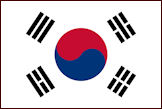
Erstmals seit 1961 Präsidentenwahlen in Südkorea. Wahlsieger ist Ex-General Roh Tae-woo (노태우 / 盧泰愚, 1932 - ).
Abb.: Roh Tae-woo (노태우)
[Bildquelle: CHERIE A. THURLBY / DoD / Wikipedia. -- Public domain]
1987-12-22
Im King Chulalongkorn Memorial Hospital (โรงพยาบาลจุฬาลงกรณ์) gelingt die erste Herztransplantation Thailands.
1987-12-22


Ein riesiger Skandal um die Vergabe königlicher Ehrungen wird publik: Mönche stellten falsche Schenkungsurkunden aus, aufgrund derer die angeblichen "Spender" königliche Auszeichnungen für ihre "Wohltätigkeit" bekommen. Allein 1987 wurden mindestens für $55 Mio. solche falsche Bescheinigungen ausgestellt. Regierungsbeamte machten bei diesen Betrügereien gegen entsprechende Bestechungsgelder mit. Es ist üblich, dass Wohltäter für Klöster, königliche Projekte u.ä. mit der Vergabe von Titeln durch den König belohnt werden. Thailändische Titelsucht schmiert die Wohltätigkeit und - wie geschehen - auch die Korruption.
1987-12-23

USA: Premiere der Vietnamkriegs-Komödie Good Morning Vietnam von Barry Levinson (1942 - )
Abb.: ©Poster
[Bildquelel: Wikipedia. -- Fair use]
"Anders als viele andere geläufige Filme über den Vietnamkrieg (Apocalypse Now, Platoon oder Full Metal Jacket) stellt dieser Film nicht das Kampfgeschehen in den Mittelpunkt, sondern die involvierten GIs und die Zivilbevölkerung des damaligen Saigon. In dieser Komödie wechseln sich deshalb witzige mit nachdenklich stimmenden Szenen ab. Markant ist eine Szene, in der Bombenexplosionen und andere Kriegshandlungen, lautlos im Bild, von Louis Armstrongs Ballade What a Wonderful World begleitet werden, welche eigentlich erst 1967 aufgenommen wurde und daher nicht zum Zeitpunkt der Handlung (1965) passt. Auch „Ballad Of A Thin Man“ (1966) von The Grass Roots gehört dazu. Die Stimmung, die der Soundtrack insgesamt vermittelt, kann trotz seiner wenigen Abweichungen durchaus als authentisch bezeichnet werden. Obwohl der Film nicht für sich beanspruchen kann, eine akkurate Darstellung der militärischen Vorgänge in Vietnam zu sein, bemüht er sich doch, dessen Absurdität, deren Opfer unter anderem Cronauer wurde, zu vermitteln." [Quelle: http://de.wikipedia.org/wiki/Good_Morning,_Vietnam. -- Zugriff am 2013-10-12]
ausführlich: http://www.payer.de/thailandchronik/ressourcen.htm
Zu Chronik 1988 / B. E. 2531. -- 1. undatiert